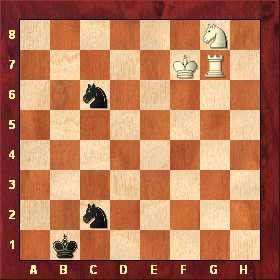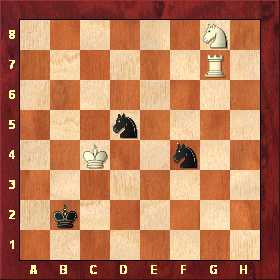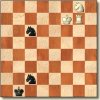Longest six-piece endgame
You probably know what endgame databases (or "tablebases") are. People
like Ken Thompson and Eugene Nalimov have actually taken certain endgames and
generated every single position that can occur in them. Working backwards from
mate they record the status of every position, and store the results in a database.
With help of these databases programs like Fritz, Junior or Shredder can play
absolutely perfect chess, at least in those ending. In any position with the
given material they are able to say whether it is a win, draw or loss, and how
many moves to mate.
One of the first endgames that was exhaustively calculated was the four-piece
ending queen vs rook. It was done by Ken Thompson back in the early eighties.
He generated every legal position with K+Q Vs K+R 1,900,000 in all
and working backwards from mates created a list in which every position contained
information with the distance to mate (the longest was 61 moves).
In the subsequent years Ken Thompson and others worked out all five-piece endings,
which have between 212 and 335 million positions each. If you buy one of our
chess programs, they will already play a number of four and five-piece endings
(e.g. Q Vs R or R+P Vs R) perfectly. With the "Endgame Turbo" (ChessBase
shop, click "Fritz programs"), which is delivered on four CDs, our
programs will play all important five-piece endings perfectly. They will in
fact use the endgame knowledge in the search, so that games against the computer
these days usually end in mate announcements in 20 or more moves!
Thompson and Nalimov have also calculated the most interesting six-piece endgames.
These are not available on CDs, since each is between one and two Gigabyte in
size. A painful download on the Internet is the only option. However, Fritz
and other ChessBase programs are already equipped to use these databases. And
Shredder actually
has a special "endgame oracle" which allows you to do extensive research
with these databases.
Helmut Conrady, a German computer chess journalist, has been experimenting
with six-piece endings, using Shredder to find special positions and records.
One of his most remarkable discoveries (with the help of Ken Thompson) was the
following position:
Longest six-piece ending

White to move
This is the longest know win in a six-piece ending. White needs to play 262
accurate moves to mate the opponent, assuming perfect play by both sides. You
can replay the solution below, but before you do so here are some interesting
(actually "depressing" would be more apt) facts about the the endgame
and the above position.
-
The number of positions in the endgame K+R+N Vs K+N+N with White to move
is exactly 17,823,400,766. They have all been calculated and are all contained
in the database. 70.08% of them are winning for White.
-
The above position is the only one (excluding its mirror positions) in
this ending that requires 262 moves to mate. All other of the thousands
of billions of positions are shorter wins (or drawn).
-
In the course of the solution White exceeds the fifty-move rule no less
than five times.
-
If the black king were on a1 instead of b1 in the above position the number
of moves to mate is reduced by 141 moves (to 121 moves). If it were on a2,
b2 or c1 the position would be a draw.
-
It is quite likely that nobody will ever understand the point of the moves
which the computer tells us are necessary. If you replay the solution you
will feel that White sometimes makes no progress for dozens of moves. Then
he seems to restrict the black knights, only to let them go for the next
30 or 40 moves.
- Of the first 14 moves in the solution to the above position eleven white
moves are absolutely forced. This means that if White does not find the only
accurate move the game is immediately drawn. There is a phase from move 125
to move 134 in which White has to make ten accurate moves. Any deviation from
the forced line loses half a point.
In the above position the only move that wins (= mates in 262 moves) is 1.Ke6!!
Helmut Conrady writes: "Only the chess god Caissa knows why in a position
without enemy contact or direct threats exactly this one unique move must be
played." The best black reply is 1...N6b4! If he plays anything
else he shortens the game by at least 143 moves, e.g. 1...Kc1 = mate in 119,
1...N6d4 = mate in 117 or 1...Na5 = mate in 106.
In our analysis any move with two exclamation marks indicates that it is the
only white move that retains the win. Every other move draws. A single exclamation
mark (!) indicates that this move leads to the shortest mate all other
moves will delay the win unnecessarily. For Black a single exclamation mark
means this is the only move that doesn't shorten White's win.
The first eight moves of the solution are 1.Ke6!! N6b4! 2.Ke5!! Nd3+! 3.Ke4!!
Nf2+! 4.Kf3!! Nd3! 5.Ke2! Ncb4! 6.Ke3!! Kb2! 7.Kd4!! Nf4! 8.Kc4! Nbd5!

Here's a depressing question: which is the next move that White must play in
order to keep the win. There is only one single move he must find, all others
lead to a position in which Black can draw. Write down five candidate moves
and then check whether the correct one is among them when you play through the
solution.
You can play through the main line of this endgame on our Javascript
board. If you want full analysis with replayable variations you can
download the game in CBV format
(41 KB), which can be read by ChessBase, Fritz or any compatible chess program.
Maybe we are wrong, maybe with a few decades of intense work you will be able
to understand this endgame.

























